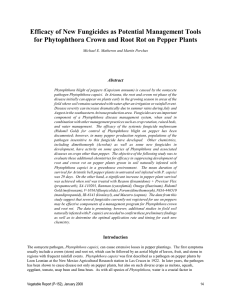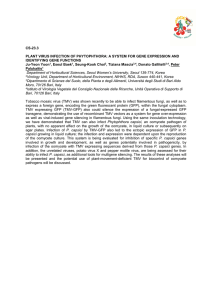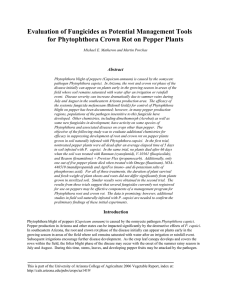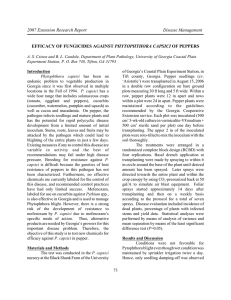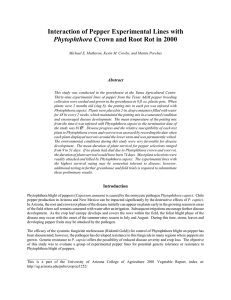Effect of Evaluation Method on Efficacy of Fungicides for Managing
advertisement
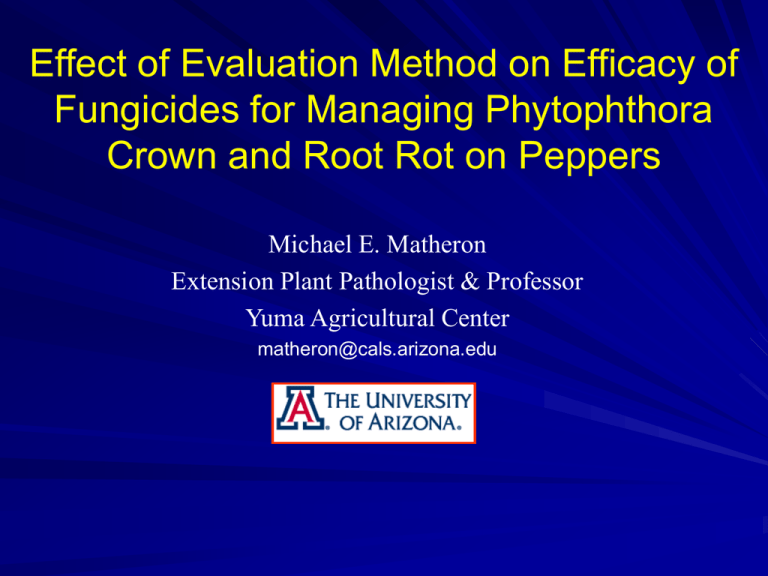
Effect of Evaluation Method on Efficacy of Fungicides for Managing Phytophthora Crown and Root Rot on Peppers Michael E. Matheron Extension Plant Pathologist & Professor Yuma Agricultural Center matheron@cals.arizona.edu Phytophthora root and crown rot on peppers Disease cycle for Phytophthora capsici on pepper Ristaino and Johnston Disease cycle for P. capsici on pepper Stem lesion Leaf lesions Oospore Oospore produces sporangium Fruit rot Root and crown rot Zoospores develop in sporangium and are released Disease cycle for P. capsici on pepper Stem lesion Leaf lesions Oospore Oospore produces sporangium Fruit rot Root and crown rot Zoospores develop in sporangium and are released Fungicide efficacy trials Inoculation of pepper plant stems with P. capsici – Fungicides applied to foliage and stems Soil infestation with P. capsici for plants grown in pots in the greenhouse – Fungicides applied by soil drench Soil infestation with P. capsici for plants seeded and grown in the field – Fungicides applied to soil surface and base of plants Fungicides evaluated Product trade name (Source) FRAC number Active ingredient Actigard (Syngenta) P Acibenzolar-S-methyl Aliette (Bayer) 33 Fosetyl-Al Forum (BASF) 40 Dimethomorph Omega (Syngenta) 29 Fluazinam Presidio (Valent) 43 Fluopicolide Previcur Flex (Bayer) 28 Propamocarb Ranman (FMC) 21 Cyazofamid Reason (Bayer) 11 Fenamidone Ridomil Gold (Syngenta) 4 Mefenoxam Revus (Syngenta) 40 Mandipropamid Protocol for pepper stem inoculation 4-month-old chile pepper plants used in this trial A circular area of epidermis removed from stem with a 5-mm diameter cork borer about 8 cm from potting mix surface Plant foliage and stem submerged for 2 seconds in a test fungicide solution, then laid horizontally on paper towel until dry Protocol for pepper stem inoculation (continued) Plants maintained in lath house for 7 days, then inoculated with a 5-mm-diameter agar disk containing mycelium of P. capsici, which was held in place with plastic tape 7 days after incubation at 27°C, the length of resultant stem cankers was recorded Suppression of stem canker growth 2009 Growth chamber trials D CD CD C C C BC BC BC A Mean length of canker on untreated stems was 99 mm Greenhouse studies - 2009 2-month-old pepper plants transplanted into 500 ml capacity pots containing potting mix infested with P. capsici Tested products applied as a soil drench in 200 ml of water per pot At transplanting and 14, 28 and 42 days later Greenhouse studies - 2009 (continued) Each pot was placed in a shallow container (4 cm deep), which was filled with water daily Plants maintained in greenhouse for about 2 months 10 replicate plants per treatment for each of 2 trials Greenhouse studies The following data were collected either during or at the end of the experiment – – – – Duration of plant survival Fresh weight of plant shoots Incidence of crown rot Final plant mortality Suppression of root and crown infection 2009 Greenhouse trials All nontreated plants were dead by 3 weeks after beginning of trial Inoculated field trials Chile pepper seed planted early April in a single row on beds 106 cm apart, then thinned to a 30 cm spacing (at UA Yuma Agricultural Center) Each treatment consisted of five replicate plots, each 4.6 m long Inoculated plots each received 150 cm3 of vermiculite infested with P. capsici, placed 5 cm deep and 8 cm from plant stems in late June Tested products applied to soil and base of plants as a drench in 750 ml of water per 15-plant plot when inoculated and 14, 28, and 42 days later Inoculated field trials Pepper plants were generously irrigated weekly Final disease incidence recorded in late September by counting the number of dead plants in each plot Suppression of root and crown infection Summary of three field trials Mean percentage of untreated plants that died per plot was 53% Suppression of root and crown infection Summary of three field trials Mean percentage of untreated plants that died per plot was 53% Fungicide efficacy from different trials Possible reasons for differences in fungicide efficacy among experiments Omega is known to be a weak inhibitor of mycelial growth (stem inoculation), but very active against sporangia and zoospores (soil application) Generally higher disease control observed in greenhouse compared to field trials – More thorough incorporation of fungicides within soil in a pot compared to application to soil in the field Canyon de Chelly Arizona Highways


